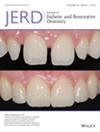Remineralization efficiency of three different agents on artificially produced enamel lesions: A micro-CT study
Abstract
Objective
This study aimed to assess the remineralization efficacy of casein phosphopeptide-amorphous calcium phosphate (CPP-ACP), silver diamine fluoride/potassium iodide (SDF/KI), and sodium fluoride with functionalized tricalcium phosphate (NaF/fTCP) on artificial early enamel lesion using laser fluorescence and micro-CT analysis.
Methodology
On extracted impacted third molars, artificial enamel lesions were prepared. Twenty-eight specimens were randomly assigned to four groups (n = 7 per group): a control group (artificial saliva), CPP-ACP (GC Tooth Mousse), SDF/KI (Riva Star), and NaF/fTCP (Clinpro White varnish). Following the manufacturer's instructions, the remineralization agents were applied to demineralized surfaces. Laser fluorescence and micro-CT were used to evaluate the remineralization efficacy of the agents and analyzes were performed during four stages: before demineralization, after demineralization, 1st day of remineralization and 30th day of remineralization. Shapiro–Wilk test, repeated measures two-way ANOVA, and Spearman correlation tests were used for statistical analysis. A significant level of p < 0.05 was established.
Results
SDF/KI significantly reduced the lesion area and lesion volume on the demineralized enamel surface after 30 days of remineralization. In the T3 period, SDF/KI increased the mineral density statistically significantly compared to the T1 period. The laser fluorescence values for all three remineralizing agents exhibited a linear decrease. A significant correlation between the fluorescence values and the mineral density was found (p = 0.01).
Conclusion
All three investigated agents were showed positive remineralization efficacy on artificial enamel lesion. However, SDF/KI, containing silver diamine fluoride and potassium iodide exhibited superior than other agents in promoting remineralization.
Clinical Significance
Although all three remineralization agents showed positive remineralization efficacy on artificial enamel lesions, SDF had higher remineralization performance over the other two agents. SDF has potential to prevent progression of demineralization in treating children with high caries risk in the long-term.


 求助内容:
求助内容: 应助结果提醒方式:
应助结果提醒方式:


